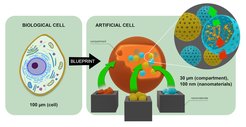Research | Dept. Landfester
Health
The Max Planck Institute for Polymer Research (MPI-P) and the University Medical Center of the Johannes Gutenberg University Mainz are collaborating in the Center for Translational Nanomedicine to bring drug delivery systems to the clinic. This bridges the gap between medical needs and excellent basic research. Nanocarrier research focuses on altering the body distribution of novel molecules such as mRNA, siRNA, or known drugs to make them usable at all or to use lower doses. This leads to higher efficacy and/or lower side effects. Classical pharmaceutical approaches as well as novel immunomodulatory agents for the treatment of cancer and (auto)immune diseases such as rheumatism are the focus of this collaboration.
Besides understanding the fundamental hurdles, e.g. due to nanocarrier-protein interaction, we aim to use pharmaceutical ingredients in a standard process here, which includes the use of closed systems so that injectable drug delivery systems are obtained. This pathway aims to scale up the nanocarrier synthesis process and apply the nanocarriers in preclinical and clinical studies in vivo.
Objectives:
- Identify medical need from applications in clinical use,
- Translate medical need into a scientific question,
- Understand opportunities and obstacles of nanocarriers in the complex biological environment of blood plasma and in whole organisms,
- Develop a process that uses pharmaceutical excipients that can be converted to a Good Manufacturing Practice (GMP) process,
- Develop assays for testing nanocarriers during production and for batch-to-batch release,
- Conduct in vivo studies for efficacy and toxicology,
- Convert to a process that can be performed in a pharmaceutical or industrial company.

Sustainability
The modern world requires new sustainable chemistry solutions to combat emerging challenges. Our department focuses on two key aspects, sustainable agriculture and light driven reactions. New solutions are required to feed our ever expanding population, where a symbiotic relationship with the environment is required for sustainable agriculture. Specifically, Varroa destructor mite is an invasive pest causing colony collapse disorder. Traditional insecticidal control measures are unsuitable for controlling this invasive pest. Through, monitoring and manipulating the 3D temperature of the colony the vitality of this superorganism can be observed, and mite fertility can be controlled. Secondly, biodegradable nanocarriers have been developed for the delivery of fungicides. Here, lignin based nanocarriers have been developed to combat the grapevine disease Esca.
Sunlight is an abundant and renewable energy source and can be utilized for driving chemical reactions. Our research focuses on producing new heterogeneous photocatalysts that can be used for the production of high value compounds. Moreover, photocatalytic materials have been produced for the efficient remediation of pollutants in waste water.

Synthetic cells
Bottom-up Synthetic Biology: Building Cells from Scratch

Cells are biological machines that can perform an enormous number of tasks precisely and efficiently. They do that by organizing intricate processes in functional modules of increasing complexity contained in soft compartments. This realization has inspired scientists to apply engineering principles to build artificial cells using bio-inspired building blocks, natural or synthetic. The motivation behind building synthetic cells and organelles from scratch, also known as the bottom-up approach, is that we gain full control over the structure, functions, and behavior of the cells we create in the lab. Moreover, the bottom-up approach allows us to understand how cells work and to use that knowledge to create new materials that will help us create sustainable solutions for global technological challenges. Results of this research will be used to create efficient drug delivery systems, powerful chemical and biological sensors, systems for CO2 fixation, and bioreactors for minimized waste generation or deactivation of toxins in water. In our group, we build and design functional modules and cell-like systems (synthetic cells and organelles) using methods from polymer chemistry, nanotechnology, biochemistry, and materials science.


